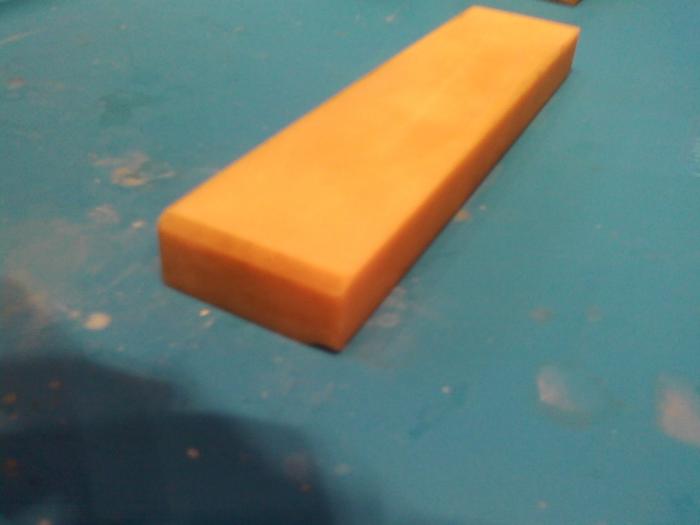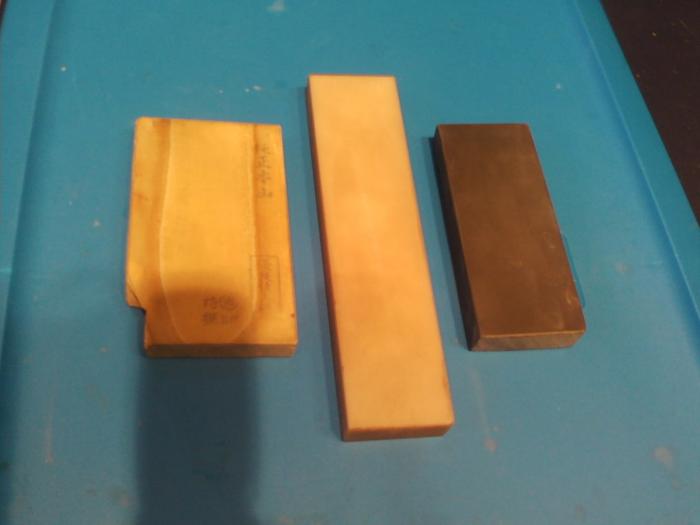Results 1 to 10 of 14
Thread: Flattening an Arkansas stone
-
07-10-2009, 02:40 AM #1Razor honing maniac


- Join Date
- Jun 2009
- Location
- On the beautiful St. Croix river
- Posts
- 228
Thanked: 51 Flattening an Arkansas stone
Flattening an Arkansas stone
I have an old set of hones from Cabelas. It contains 1- Hard Arkansas, 1-Soft Arkansas and 1- Wa****a Stone.
Question: Can I use a Norton Flattening stone to bring these stone around? They have not been used very much and would like to use them if possible. Any opinions on the quality and effectiveness of these stone?
-
07-10-2009, 02:51 AM #2

Arkansas stones are natural stones and will act differently. i have couple of them and the best one is translucent 10 in app long. does excellent finishing job(i think you call this hard arkansas). About lapping them it is PITA . i used dmt and even that took me a lot time to get it flat condition.Norton lapping stone i have never used can't say anything about it. hope this helps
-
07-10-2009, 02:52 AM #3

i just got through laping a new one i got it is a natural stone uncut sides top and bottom has been flatend so i laped the topside and rounded one side , it took 5 sheets of norton 150 w/d sand paper and still had marks on hone so i got 325 dmt and 30 min. later it was flat , as far as your ark. hard it willbe around 4 to 6k , the soft will be around 1k they work well but are slow cuters,
-
07-10-2009, 04:54 AM #4Hones & Honing




- Join Date
- May 2005
- Location
- Saint Paul, Minnesota, United States
- Posts
- 8,023
- Blog Entries
- 1
Thanked: 2209
Hello,

A large number of people have asked the same questions in the past. The answer is that they are a bear to lap. A Dmt Diamond hone is about the only practical method. Use the 325 grit for the bulk of the work then go to a finer grit DMT or silicon carbide sandpaper to finish it off up to 1000 grit.
The Hard Arkansas stones are very slow cutters and most people don't have the patience for them (that includes me! ).
).
You would be much better off purchasing the more tried and true hones, Belgian natural combo hone, Norton 4/8, Shapton Glass or Naniwa hones.
Hope this helps, Randolph Tuttle, a SRP Mentor for residents of Minnesota & western Wisconsin
Randolph Tuttle, a SRP Mentor for residents of Minnesota & western Wisconsin
-
07-10-2009, 05:18 AM #5Senior Member

- Join Date
- Apr 2009
- Posts
- 786
Thanked: 132
I'm relatively new to honing straights, so im not qualified to tell you 'what' hones to use, but i can tell you how i lap the arkansas stones i have, since you already have them yourself.
I have a soft, hard and surgical black arkansas...i use a permanent, black marker to mark a grid on them, (since pencil markings are not resilient enough.)
Then i use a combination 400/1000 grit diamond hone and lap until marks are gone.
The wash*ta and soft arkansas, was easy to lap...once ya get to the hard arkansas and on up, the longer it will take.
It took me days to get all three lapped properly...but to me, it was worth it.
Good luck,
MacLast edited by McWolf1969; 07-10-2009 at 05:42 AM.
-
07-10-2009, 05:21 AM #6

I don't know if the stone I am lapping is really an Arkansas stone. It is a really hard caramel colored stone. I have alternated between the Norton and the DMT coarse. I did it to relieve the boredom (as it has become a little flatter over the last 3 days). The flat area has been expanding. I have an area large enough to do some honing with it. It has a very fine scratch pattern. I have gotten some decent shaves off razors I finished on it.
Last edited by Pyment; 07-10-2009 at 05:24 AM.
-
07-10-2009, 05:58 AM #7
-
07-10-2009, 07:10 AM #850 year str. shaver


- Join Date
- Aug 2008
- Location
- Pothole County, PA
- Posts
- 2,258
- Blog Entries
- 2
Thanked: 522 $64 Question
$64 Question
Once I have my Black Ark perfectly flat, can I use it as a flattening stone for anyother stones? Since it is so hard, would it be good for flattening softer stones?
_____________JERRY
OOOPS! Pass the styptic please.
-
07-10-2009, 03:32 PM #9

here are some pics:


That's my Nakayama on the left and the Olivia hone on the right.
-
07-10-2009, 06:58 PM #10Senior Member

- Join Date
- Feb 2007
- Location
- Chicagoland
- Posts
- 844
Thanked: 155
Arkansas stones are novoculite, essentially pure silica, they are hard and very slow cutting. They are not waterstones, that is, the stone does not form a slurry when used and the surface does not ablate. Because of this, they do not wear down a quickly as waterstones and once lapped, remain flat for a very long time. Since they are pure silica, they can only be lapped with a material that is harder than silica. Be sure to use plenty of water when lapping as you can easily polish the stone, rendering it useless as a sharpening tool.
You can use either water or oil as a lubricant (and you need to use one or the other to prevent loading the stone with metal particles), once oil is used on a stone, however, you lose the water option.
I'm not sure what the stone you show in the picture is, I have never seen an orange arkansas stone, they are usually either white or grey.


 LinkBack URL
LinkBack URL About LinkBacks
About LinkBacks






 Reply With Quote
Reply With Quote

